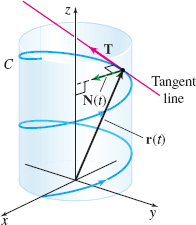EXAMPLE 4Finding the Principal Unit Normal Vector of a Helix
Show that the principal unit normal vector N(t) of the helix r(t)=costi+sintj+tk
is orthogonal to the z-axis.
Solution We begin by finding r′(t) and ‖ \begin{equation*} \mathbf{r}^{\prime} (t)=-\!\sin t\mathbf{i}+\cos t\mathbf{j}+\mathbf{k}\qquad \left\Vert \mathbf{r}^{\prime }(t)\right\Vert =\sqrt{ (-\!\sin t)^{2}+(\cos t)^{2}+1}=\sqrt{2} \end{equation*}
Then the unit tangent vector is \mathbf{T}(t)=\dfrac{\mathbf{r}^{\prime }(t)}{||\mathbf{r}^{\prime }(t)||}=\dfrac{-\!\sin t\mathbf{i}+\cos t\mathbf{j}+\mathbf{k}}{\sqrt{2}}.

Since \begin{equation*} \mathbf{T}^{\prime} (t)=\dfrac{-\!\cos t\mathbf{i}-\sin t\mathbf{j}}{\sqrt{2} }\qquad \hbox{and}\qquad \left\Vert \mathbf{T}^{\prime }(t)\right\Vert =\sqrt{ \left( -\dfrac{\cos t}{\sqrt{2}}\right) ^{2}+\left( -\dfrac{\sin t}{\sqrt{2}} \right) ^{2}}=\dfrac{1}{\sqrt{2}} \end{equation*}
we have \begin{equation*} \mathbf{N}(t)=\dfrac{\mathbf{T}^{\prime} (t)}{\left\Vert \mathbf{T}^{\prime} (t)\right\Vert }=-\!\cos t\mathbf{i}-\sin t\mathbf{j} \end{equation*}
Since the direction of the z-axis is \mathbf{k}, it follows that \mathbf{N}(t)\,{\cdot}\, \mathbf{k}=0 for all t. So, \mathbf{N}(t) is always orthogonal to the z-axis, as shown in Figure 14.